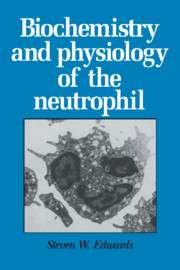Book contents
- Frontmatter
- Contents
- Abbreviations
- Preface
- 1 Neutrophils and host defence: The fight against infection
- 2 The development and structure of mature neutrophils
- 3 The generation and recognition of neutrophil-activating factors: Structure and function of neutrophil receptors
- 4 The cytoskeleton: The molecular framework regulating cell shape and the traffic of intracellular components
- 5 The respiratory burst: The generation of reactive oxygen metabolites and their role in microbial killing
- 6 Neutrophil activation: The production of intracellular signalling molecules
- 7 Neutrophil priming: Regulation of neutrophil function during inflammatory activation
- 8 Disorders of neutrophil function
- Index
3 - The generation and recognition of neutrophil-activating factors: Structure and function of neutrophil receptors
Published online by Cambridge University Press: 26 February 2010
- Frontmatter
- Contents
- Abbreviations
- Preface
- 1 Neutrophils and host defence: The fight against infection
- 2 The development and structure of mature neutrophils
- 3 The generation and recognition of neutrophil-activating factors: Structure and function of neutrophil receptors
- 4 The cytoskeleton: The molecular framework regulating cell shape and the traffic of intracellular components
- 5 The respiratory burst: The generation of reactive oxygen metabolites and their role in microbial killing
- 6 Neutrophil activation: The production of intracellular signalling molecules
- 7 Neutrophil priming: Regulation of neutrophil function during inflammatory activation
- 8 Disorders of neutrophil function
- Index
Summary
Most if not all of the naturally-occurring neutrophil-activating factors elicit their effects on neutrophils after binding to specific receptors on the plasma membrane. Therefore, this chapter describes how many of these factors are generated (many may be generated by the neutrophils themselves) and how they are thought to mediate their effects; where possible, details of the corresponding receptor will be given. In addition, this chapter includes descriptions of the structure and function of the complement and immunoglobulin receptors involved in the regulation of many neutrophil functions, such as adhesion and opsonophagocytosis.
Leukotriene B4
Properties
Leukotrienes are generated via the activities of lipoxygenases on arachidonic acid. Arachidonic acid itself is generated largely via the activity of phospholipase A2 on membrane polyunsaturated fatty acids, although it may also be formed via the activity of diacylglycerol lipase on sn-l,2-diacylglycerol (see § §6.3.1.1, 6.3.1.5). Different cells possess lipoxygenases that oxidise arachidonic acid at different C atoms on the molecule. For example, platelets possess 12-lipoxygenase, mast cells have 11-lipoxygenase, but neutrophils, eosinophils, basophils, monocytes and macrophages have 5-lipoxygenase. The initial product of 5-lipoxygenase on arachidonic acid is the short-lived molecule 5-hydroxyperoxy-eicosatetraenoic acid (5-HPETE), which is converted into the unstable peroxide LTA4. In neutrophils, monocytes and pulmonary macrophages, this LTA4 is then reduced to LTB4 (Fig. 3.1) via epoxide hydrolase.
- Type
- Chapter
- Information
- Biochemistry and Physiology of the Neutrophil , pp. 77 - 127Publisher: Cambridge University PressPrint publication year: 1994
- 3
- Cited by



